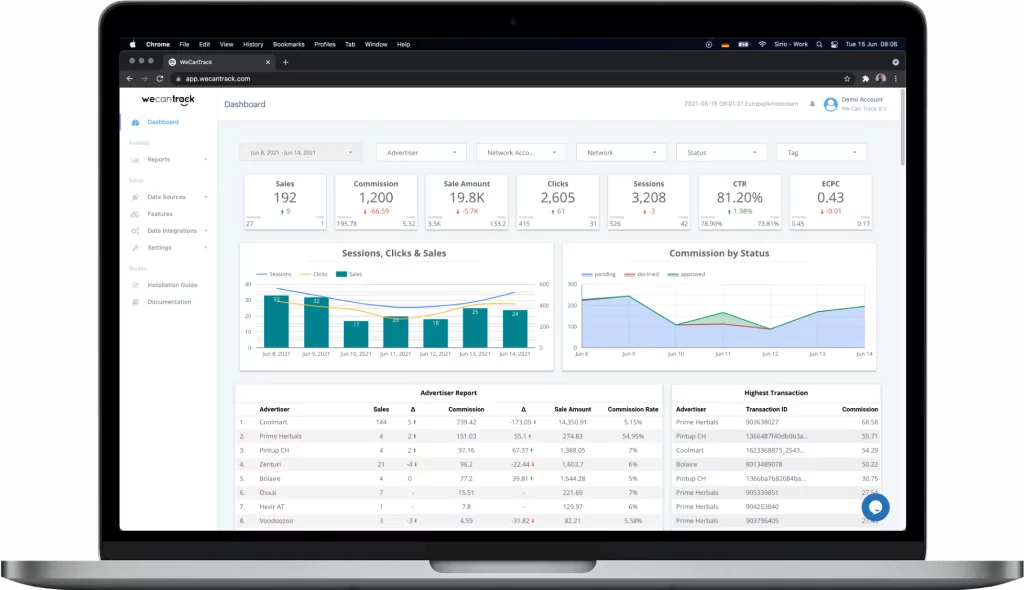The model of CPA affiliate marketing, or Cost Per Action marketing, offers a unique opportunity where affiliates earn commissions only when specific actions—like filling out forms, signing up for trials, or making purchases—are completed.
CPA benefits advertisers by linking payments directly to concrete results and rewards affiliates with potentially higher earnings for successful conversions. Various payment models such as CPA, CPI, CPL, and CPS add flexibility, allowing both parties to align with their strategic goals.
The process is straightforward: advertisers pay affiliates based on the actions their referrals take. Affiliates use compelling content, SEO, social media, and email marketing, among other strategies, to drive these actions. They track their success with unique referral codes or links, ensuring they are paid fairly for their efforts.
By fostering a performance-based relationship, CPA affiliate marketing becomes a powerful tool for driving customer acquisition and offering affiliates a rewarding avenue for generating leads and conversions.
Table of Contents
Why Choose CPA Affiliate Marketing?
CPA affiliate marketing presents compelling advantages for both advertisers and affiliates. Advertisers enjoy low financial risk as they only pay for tangible results, such as a sale or lead, enabling effective budget management and a favorable return on investment.
Affiliates, on the other hand, have the chance to earn commissions by promoting a diverse range of products and services, getting paid for each successful action they facilitate.
This model is notably scalable, allowing both advertisers and affiliates to extend their reach and engage a broader audience. The ability to track and analyze performance ensures high conversion rates, focusing efforts on the most impactful strategies.
Additionally, the global scope of CPA affiliate marketing opens up vast markets, providing ample opportunities for growth and profitability. These benefits—ranging from financial prudence to expansive market access—make CPA affiliate marketing an appealing and rewarding strategy for both parties involved.
Getting Started With CPA Affiliate Marketing
Whether you are an experienced marketer aiming to expand your revenue sources or a newcomer eager to explore fresh opportunities, we will outline the critical principles and tactics needed for success in CPA affiliate marketing.
With the right knowledge and strategies, you can use CPA marketing to create a passive income stream and establish a lasting online business.
Finding The Right CPA Network
Choosing the right CPA network involves evaluating payout rates, payment frequency, and reputation. Consider networks like MaxBounty, known for competitive payouts and reliable monthly payments; PeerFly, celebrated for its frequent payments and strong industry reputation; and A4D, which offers high payout rates and options for weekly or bi-weekly payments.
It’s crucial to select a network that not only provides favorable payouts and frequent disbursements but also holds a solid reputation for fairness and consistency.
Selecting The Right Affiliate Program
When selecting an affiliate program, key considerations include commission rates, relevance of the product to your audience, and the program’s payment track record.
Aim for programs offering competitive commissions and products that resonate with your target audience to ensure high conversion rates. Verify the program’s reliability through its history of timely and accurate payments.
Whether it’s pay-per-sale, pay-per-lead, or pay-per-click, each model offers unique benefits and should align with your marketing strategies and audience preferences.
Understanding The Types Of Affiliate Campaigns
Affiliate marketing varies significantly across campaigns like pay-per-click (PPC), pay-per-lead (PPL), and pay-per-sale (PPS). PPC campaigns pay for clicks regardless of purchase, while PPL campaigns reward generating leads, like sign-ups, and PPS campaigns pay a commission per sale.
Each type has its advantages: PPC ensures earnings without purchases, PPL often offers higher commissions for leads, and PPS can yield substantial earnings from sales percentages. However, the choice depends on your strategy, effort level, and desired income stability.
Choosing Quality Traffic Sources
Effective traffic sources for affiliate marketing include search engine optimization (SEO), social media advertising, and influencer partnerships.
SEO involves targeting specific keywords and creating valuable content to boost organic traffic and conversions.
Social media advertising leverages detailed audience targeting to maximize ROI, while influencer partnerships tap into pre-established trust to drive traffic.
Each strategy requires careful planning and targeting to ensure the traffic is not only abundant but also high quality and relevant to the advertised products or services.
Building A Successful CPA Affiliate Marketing Strategy
Building a successful CPA affiliate marketing strategy demands meticulous planning and tactical execution. It centers on a collaborative relationship between a company and an affiliate, with the affiliate earning a commission for each customer action, such as a purchase or signup.
To forge a prosperous strategy, start by gaining a deep understanding of your target audience. Choose CPA offers that resonate with their interests and deploy impactful marketing techniques to boost traffic and conversions.
Continuous analysis and optimization of your strategy are vital to achieve optimal results and maximize your return on investment. With the correct approach, CPA affiliate marketing can become a profitable venture for both companies and affiliates.
Setting Goals and Objectives
Setting clear, measurable, and achievable goals is vital for steering an organization towards success. Such goals provide direction, helping everyone in the organization focus on common objectives. Measurable goals allow for tracking progress and evaluating performance, which is crucial for understanding how well the organization is doing.
Achievable goals are motivating, reducing frustration by ensuring employees can see and appreciate the progress they’re making. Overall, well-defined goals are fundamental to driving success and celebrating achievements within the organization.
Identifying Target Audience and Niche Market
It is essential to diligently conduct market research and analyze customer data to understand the demographic details, interests, and needs of your niche market.
This knowledge enables tailored marketing strategies, product development, and a customer experience that resonates well with our target audience, effectively meeting their specific needs and preferences.
Creating Effective Landing Pages for Form Submissions
An effective landing page is key to converting visitors into leads through form submissions. Essential elements include a compelling headline that grabs attention, persuasive copy that communicates the offer’s benefits, and a user-friendly form that is straightforward to fill out and submit.
Optimal landing page design minimizes distractions, focusing the visitor’s attention on completing the form. Persuasive elements should clearly articulate the value of the offer, overcoming any potential hesitations.
Effective design, clear visuals, and minimal form fields enhance user engagement and improve conversion rates. Regular A/B testing is recommended to fine-tune these elements and maximize effectiveness.
Developing Relationships with Affiliate Partners
To build effective affiliate partnerships, identify potential partners with a similar target audience and offer complementary products or services.
Start by researching companies that align with your values and have a robust online presence. Initial outreach should be personalized, emphasizing the mutual benefits such as increased reach and enhanced sales potential.
Establishing relationships with the right partners ensures both parties benefit and enhances the overall experience for customers. By collaborating on marketing efforts and leveraging each other’s strengths, affiliate partnerships can significantly increase brand exposure, open new customer channels, and generate additional revenue streams.

Success in an affiliate network goes beyond its size, encompassing trust, transparency, and timely payouts. It's about fostering a community where affiliates and advertisers thrive together, empowered by cutting-edge technology and a commitment to excellence.
Maximizing Profit with CPA Affiliate Marketing
CPA affiliate marketing is a powerful strategy for businesses looking to maximize profits by paying only for specific results, such as lead generation, sales, or form completions. This approach eliminates the risk of upfront advertising costs by partnering with affiliates who actively promote your business and drive desired actions.
Such a model allows for precise budget allocation and detailed tracking of return on investment for each campaign, enhancing profitability.
Exploring Different Payment Methods in CPA Marketing
Choosing the right payment method depends on the affiliate’s marketing strategy and audience. Additionally, selecting a payment processor is crucial and should involve careful evaluation of their fees, customer support, and fraud prevention capabilities, including chargeback protection.
This protects affiliates’ earnings and minimizes risks associated with fraudulent activities. Affiliates need to consider their options thoughtfully to align with their goals, ensuring they maximize earnings and mitigate potential risks effectively.
What We’ve Learned
CPA affiliate marketing stands out as a strategic choice for businesses aiming to enhance their profitability without shouldering the high initial costs typically associated with traditional advertising.
By focusing on performance-based outcomes, companies can ensure they only spend on marketing that results in actual gains—be it through sales, leads, or specific actions taken by customers.
As you embark on or refine your CPA affiliate marketing journey, remember that success lies in continuous optimization and learning. Keep testing different strategies, adjusting your approaches based on performance insights, and staying updated with the latest trends in affiliate marketing.
By doing so, you can build a robust marketing strategy that not only drives your business forward but also maximizes your return on investment in a scalable and sustainable manner.
Whether you’re just starting out or looking to enhance your existing efforts, CPA affiliate marketing offers a promising pathway to growth and profitability.




